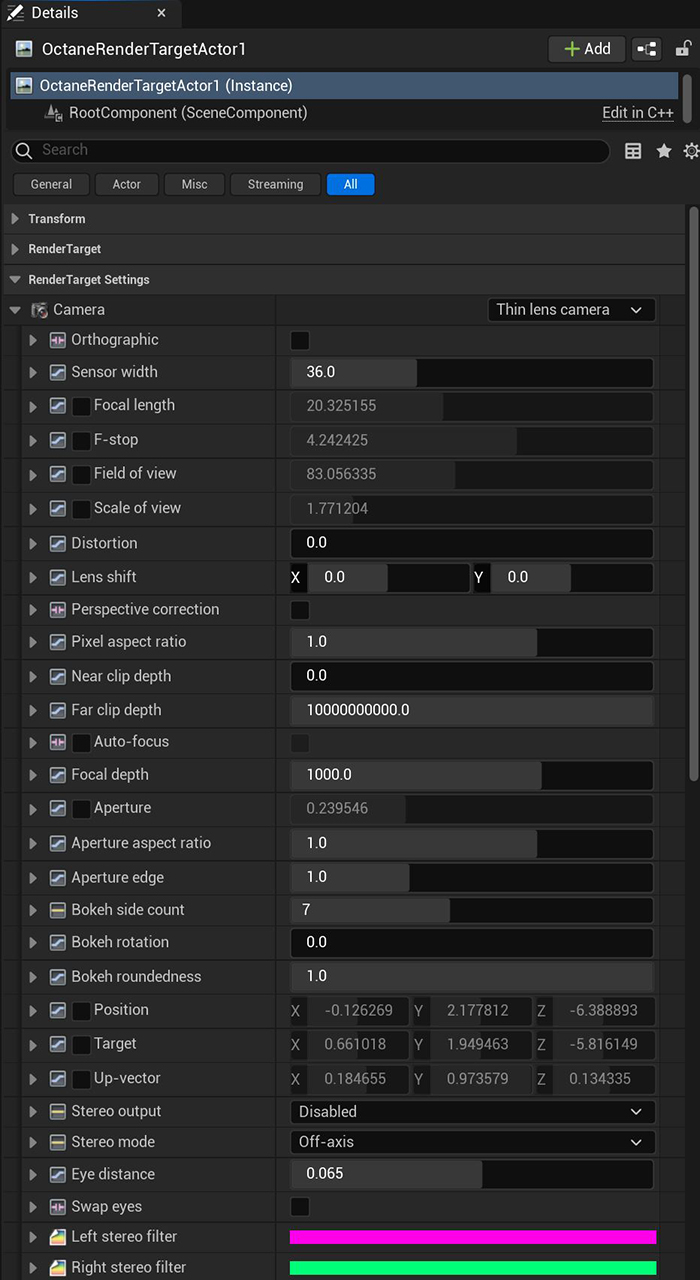
The Thin Lens camera is the standard camera type used for most normal rendering purposes. This camera type is accessible by clicking on the Octane Render Target Actor, then clicking on the Details panel, followed by clicking on the Camera dropdown.

Figure 1: The Thin Lens Camera type
Orthographic - If enabled, the camera shows an orthographic view. If disabled, the camera shows a perspective view.
Sensor Width - The sensor's or film's width in millimeters.
Focal Length - The lens's focal length in millimeters.
F-Stop - The aperture-to-focal-length ratio.
Field Of ViewThe area that is visible to a camera lens usually measured in millimeters. A wide angle lens provides a larger field of view and a telephoto lens provides a narrow field of view. - Sets the camera's horizontal field-of-view for the scene, measured in degrees. Large values show more of the scene in the camera. Smaller values show less of the scene in the camera.
Scale Of View - Sets the the orthographic view's width in the camera, shown in meters.
Distortion - Adjusts the spherical and cylindrical distortion. The rendered image displays the entire sphere and uses equidistant cylindrical projection, also known as lat-long projection.
Lens Shift - This is useful for architectural rendering when you want to render images of tall buildings or structures from a similar height as the human eye, but keep the vertical lines parallel.
Perspective Correction - If the Up-Vector value is vertical, enabling this option keeps vertical lines parallel.
Pixel Aspect Ratio - Makes the pixel ratio non-square to accommodate older formats like NTSC or PAL.
Near Clip Depth - The distance from the camera to the near clipping plane, measured in meters. The main purpose is for interior scenes, where you can get a good shot of the whole room, but not without a very large field-of-view, because the camera needs to stay inside the room.
With camera clipping (near plane), you can position the camera outside the room by lowering the field-of-view and increasing the clipping plane distance in front until the closest walls clip out. The geometry is not altered, but the camera clipping is altered, which means that shadows, reflections, and refractions are still affected by the clipped geometry.
Far Clip Depth - TObjects farther than the specified distance from the camera aren't visible from the camera.
Auto-Focus - If enabled, the focus is kept on the closest visible surface at the center of the image, regardless of the ApertureDetermines how much light enters a camera lens. A large aperture produces a narrow depth of field and a small aperture produces a wide depth of field., Aperture Edge, and Focal Depth values. This setting is on by default.
Focal Depth - The depth of the plane in focus, measured in meters. If you are having trouble seeing a result when you adjust this setting, make sure that Auto-Focus is disabled, as it overrides the Focal Depth setting.
Aperture - The camera lens opening's radius, measured in centimeters. Low values create a deep depth-of-field, where everything is in focus. High values create a shallow depth-of-field, where objects in the foreground or background are out-of-focus.
Aperture Aspect Ratio - Squashes or stretches the depth-of-field disc.
Aperture Edge - Controls aperture edge detection at all points within the aperture. Lower values give more pronounced edges to out-of-focus objects affected by a shallow depth-of-field. Aperture Edge modifies the depth-of-field's bokeh effect. High values increase the contrast towards the edge.
Bokeh Side Count - Sets the number of edges on blurred highlights.
Bokeh Rotation - Bokeh settings adjust the quality of highlights when depth-of-field blurring is apparent. Raising the aperture increases depth-of-field blurring. Bokeh Rotation rotates the shape of the blurred highlights. This becomes more obvious when you lower the Bokeh Roundness value.
Bokeh Roundedness - Keeps blurred highlights rounded. Low values reduce the roundness and increase the appearance of edges on the highlights.
Position - The camera's X, Y, and Z positions in the scene.
Target - The target position where the camera points in the scene.
Up-Vector - This is the camera's up direction in the scene. By default, this is in the Y-direction (0, 1, 0).
Stereo Output - This specifies the output rendered in stereo.
Eye Distance - The distance between the left and the right eyes in stereo mode, measured in meters. The stereo distance is also referred to the IPD (Inter Pupillary Distance), and is often exchanged with terms like stereo interocular distance or eye distance. For realistic depth, use values between 0.055 and 0.075.
Swap Eyes - Swaps the left and right eye's images.
Left/Right Stereo Filter - The left and right filter colors adjust the anaglyphic stereo effect's colors in the render.